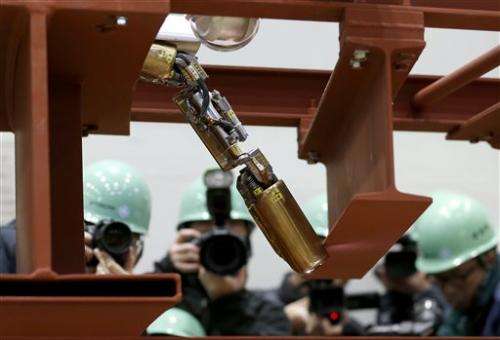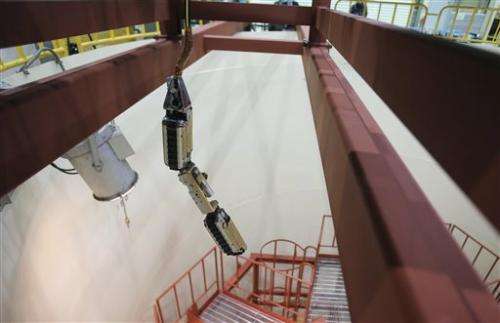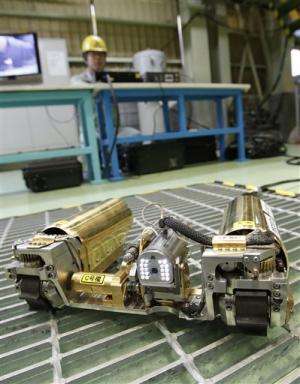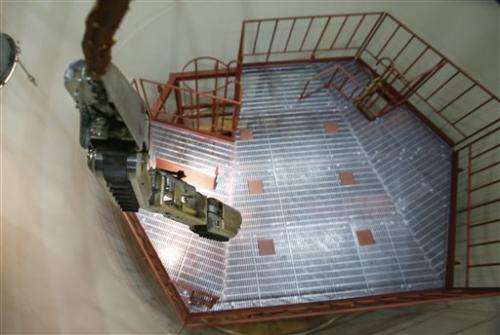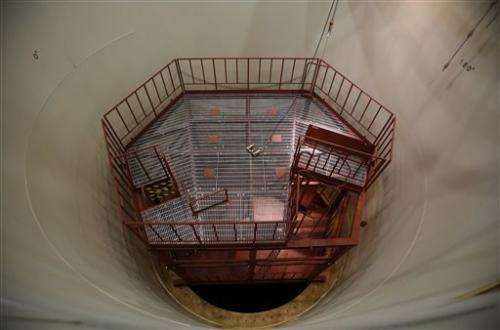In this Thursday, Feb. 5, 2015 photo, photographers take photos of a remote-controlled robot that looks like an enlarged fiberscope crawling down into the mock-up of a primary containment chamber during a demonstration for the media at a government facility in Hitachi, Ibaraki Prefecture, northeast of Tokyo. The snake-like robot, developed by Japanese electronics giant Hitachi and its nuclear affiliate Hitachi-GE Nuclear Energy, is ready to examine in April the damage inside Unit 1 reactor at the Fukushima dai-ichi nuclear plant, wrecked by the march 2011 earthquake and tsunami. (AP Photo/Shizuo Kambayashi)
(AP)—A snake-like robot designed to examine the inside of one of three melted reactors at the Fukushima Dai-ichi nuclear plant is ready to begin its expedition.
Assessing the damage inside the reactors is a crucial step in the decommissioning of the plant, which was badly damaged by a 2011 earthquake and tsunami. Use of a remote-controlled robot is essential because no humans can go close to the reactor chambers because of their fatally high radiation levels.
Using information gathered by the robot, the plant operator, Tokyo Electric Power Co., plans to repair the damaged chambers enough so they can be filled with water in preparation for the removal of melted radioactive debris, planned in about a decade.
The 60-centimeter (2-foot) -long robot, developed by electronics giant Hitachi and its nuclear affiliate Hitachi-GE Nuclear Energy, was demonstrated this week at a Hitachi-GE facility northeast of Tokyo. It is expected to enter the Unit 1 reactor as early as April, officials said.
It has a lamp at the front and is designed to crawl like a snake through a 10-centimeter (4-inch) wide pipe into the containment vessel. From there it must dangle and descend onto a platform just below the reactor core's bottom, an area known as the pedestal.
There, the robot is to transform into a U-shaped crawler and capture live images and temperature and radiation levels and transmit them to a control station outside the building.
In this Thursday, Feb. 5, 2015 photo, a remote-controlled robot that looks like an enlarged fiberscope is lowered through the mock-up of a primary containment chamber during a demonstration for the media at a government facility in Hitachi, Ibaraki Prefecture, northeast of Tokyo. The snake-like robot, developed by Japanese electronics giant Hitachi and its nuclear affiliate Hitachi-GE Nuclear Energy, is ready to examine in April the damage inside Unit 1 reactor at the Fukushima dai-ichi nuclear plant, wrecked by the march 2011 earthquake and tsunami. (AP Photo/Shizuo Kambayashi)
Expectations for the robot probe are high after earlier efforts at assessment produced limited success.
"Depending on how much data we can collect from this area, I believe (the probe) will give us a clearer vision for future decommissioning," Hitachi-GE engineer Yoshitomo Takahashi said.
After its trip, technicians plan to store the robot in a shielded box because of its extremely high radioactivity, and it will not be reused. Different robots must be designed for each reactor, since all are slightly different.
In this Thursday, Feb. 5, 2015 photo, an operator controls a robot that looks like an enlarged fiberscope during a demonstration for the media at a government facility in Hitachi, Ibaraki Prefecture, northeast of Tokyo. The snake-like robot, developed by Japanese electronics giant Hitachi and its nuclear affiliate Hitachi-GE Nuclear Energy, is ready to examine in April the damage inside Unit 1 reactor at the Fukushima dai-ichi nuclear plant, wrecked by the march 2011 earthquake and tsunami. (AP Photo/Shizuo Kambayashi)
Computer simulations indicate that all of the fuel rods in the Unit 1 reactor probably melted and fell to the bottom of the containment chamber, but until now there has been no way of confirming that. A brief fiberscope observation was conducted in 2012 but the images were scratchy and limited.
In order to assess debris on the bottom and submerged underwater, an amphibious robot is being developed for deployment next year.
Because of the reactor damage, large volumes of cooling water continue to leak from them, causing contamination and hampering the plant's cleanup process.
-
In this Thursday, Feb. 5, 2015 photo, a remote-controlled robot that looks like an enlarged fiberscope is lowered through the mock-up of a primary containment chamber during a demonstration for the media at a government facility in Hitachi, Ibaraki Prefecture, northeast of Tokyo. The snake-like robot, developed by Japanese electronics giant Hitachi and its nuclear affiliate Hitachi-GE Nuclear Energy, is ready to examine in April the damage inside Unit 1 reactor at the Fukushima dai-ichi nuclear plant, wrecked by the march 2011 earthquake and tsunami. (AP Photo/Shizuo Kambayashi)
-
In this Thursday, Feb. 5, 2015 photo, a remote-controlled robot that looks like an enlarged fiberscope moves on a deck inside the mock-up of a primary containment chamber during a demonstration for the media at a government facility in Hitachi, Ibaraki Prefecture, northeast of Tokyo. The snake-like robot, developed by Japanese electronics giant Hitachi and its nuclear affiliate Hitachi-GE Nuclear Energy, is ready to examine in April the damage inside Unit 1 reactor at the Fukushima dai-ichi nuclear plant, wrecked by the march 2011 earthquake and tsunami. (AP Photo/Shizuo Kambayashi)
© 2015 The Associated Press. All rights reserved.
